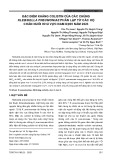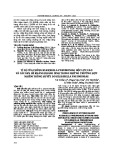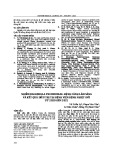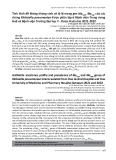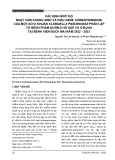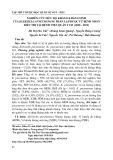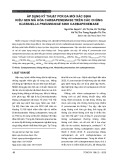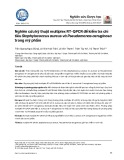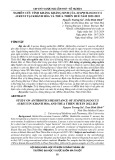
HUE JOURNAL OF MEDICINE AND PHARMACY ISSN 3030-4318; eISSN: 3030-4326 119
Hue Journal of Medicine and Pharmacy, Volume 14, No.6/2024
Clinical and laboratory characteristics and short - outcome of
neonatal sepsis
Nguyen Thi Thanh Binh1*, Hoang Mai Linh2#, Nguyen Cong Tien3
(1) Department of Pediatrics, University of Medicine and Pharmacy, Hue University
(2) Pediatric Center, Hue Central Hospital, Vietnam
(3) Tam Tri Hospital, Da Nang city, Vietnam
#Co-first author
Absract
Objectives: To describe clinical features and laboratory findings and to investigate factors associated
with neonatal sepsis mortality. Subjects and methods: A prospective cohort study was conducted involving
seventy-eight patients diagnosed with neonatal sepsis with positive blood cultures at the Neonatal Intensive
Care Unit, Pediatric Center, Hue Central Hospital. Results: The study showed that neonatal sepsis occurred
most frequently in preterm infants <34 weeks gestation (51.3%) and weighing less than 1500 grams (37.2%).
Late-onset sepsis was the most frequent type of sepsis (92.3%). Clinical symptoms varied in multiple organs,
often manifested as systemic, and respiratory symptoms. In terms of laboratory findings, leukocytosis
(>20.000/mm3) was observed in 25.6% of the cases, leukopenia (<4.000/mm3) in 15.4%, thrombocytopenia
(platelet count <100.000/mm3) in 43.6%, and hyperglycemia (14.1%). Gram-negative bacteria were the most
common causative pathogens (82.1%), followed by Gram-positive bacteria (17.9%). Klebsiella pneumoniae
and Staphylococcus aureus MRSA (+) were the most encountered bacteria, with rates of 35.9% and 14.0%,
respectively. The mortality rate associated with neonatal sepsis in this study was 16.7%. Multivariate regression
analysis showed that neonates requiring invasive mechanical ventilation and those with gastrointestinal
bleeding had a significantly higher risk of mortality, with odds ratio (OR)=100.6 (95% confidence interval (CI):
4.3-2370.7, p=0.004) and OR=42.3 (95% CI: 1.8-982.6, p=0.02), respectively. Conclusions: The mortality rate
of neonatal sepsis is 16.7%. Mechanical ventilation and intestinal hemorrhage were significant risk factors for
mortality in neonatal sepsis.
Keywords: Neonatal sepsis, mortality.
Corresponding Author: Nguyen Thi Thanh Binh
Email: nttbinh.a@huemed-univ.edu.vn; nttbinh.med@hueuni.edu.vn
Received: 16/7/2024; Accepted: 20/11/2024; Published: 25/12/2024
DOI: 10.34071/jmp.2024.6.17
1. INTRODUCTION
Sepsis, an important form of neonatal infection, is
a global challenge with high morbidity and mortality.
It is estimated that 1.3 to 3.9 million newborns
worldwide develop sepsis each year, resulting in
400.000 to 700.000 deaths [1]. Diagnosing sepsis
in newborns is often difficult because clinical signs
and symptoms and biomarkers are often nonspecific
[2]. The gold standard for diagnosing sepsis is
isolating the pathogen, usually from peripheral
blood; however, this diagnostic method often
yields late results, thereby leading to limitations in
treatment decisions in the neonate’s early stages [3].
Therefore, to contribute to improving the treatment
of neonatal sepsis, we conducted this study with the
following aims: to describe clinical and laboratory
characteristics, and to investigate factors associated
with neonatal sepsis mortality.
2. SUBJECT AND METHODS
2.1. Subjects
Seventy-eight neonates met the selection criteria
at the Neonatal Intensive Care Unit - Pediatric Center,
Hue Central Hospital.
Selection criteria: The neonates were diagnosed
with sepsis and had positive blood culture results
according to the European Medicines Agency (EMA)
2010 criteria [4].
Exclusion criteria: Parents who did not agree to
participate in the study.
2.2. Methods
2.2.1. Study design: prospective cohort study.
2.2.2. Variables and measurements: neonatal
characteristics (weight, sex, gestational age, method
of birth, and postpartum support); clinical features
of the nervous, respiratory, cardiovascular, and
gastrointestinal systems, skin; laboratory tests








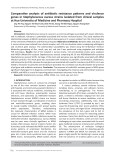
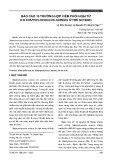
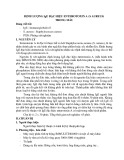

![Tổng hợp và đánh giá hoạt tính kháng khuẩn của các dẫn chất 6-iodophenyl-3h-benzo[e][1,3]oxazine 2,4-dione](https://cdn.tailieu.vn/images/document/thumbnail/2025/20250330/vimitsuki/135x160/9381743339955.jpg)
